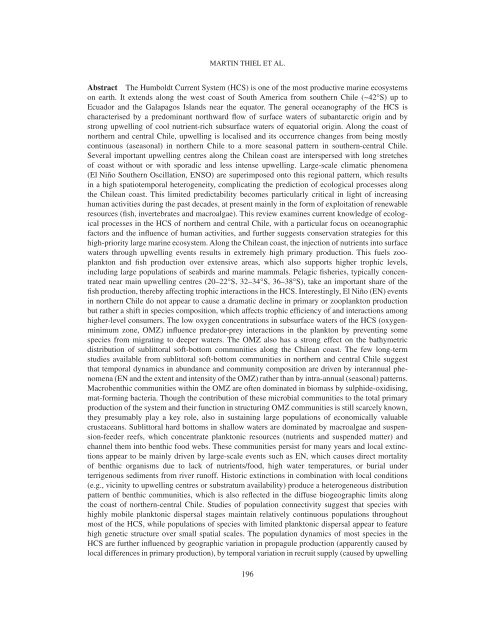the humboldt current system of northern and central chile - figema
the humboldt current system of northern and central chile - figema
the humboldt current system of northern and central chile - figema
Create successful ePaper yourself
Turn your PDF publications into a flip-book with our unique Google optimized e-Paper software.
MARTIN THIEL ET AL.Abstract The Humboldt Current System (HCS) is one <strong>of</strong> <strong>the</strong> most productive marine eco<strong>system</strong>son earth. It extends along <strong>the</strong> west coast <strong>of</strong> South America from sou<strong>the</strong>rn Chile (~42°S) up toEcuador <strong>and</strong> <strong>the</strong> Galapagos Isl<strong>and</strong>s near <strong>the</strong> equator. The general oceanography <strong>of</strong> <strong>the</strong> HCS ischaracterised by a predominant northward flow <strong>of</strong> surface waters <strong>of</strong> subantarctic origin <strong>and</strong> bystrong upwelling <strong>of</strong> cool nutrient-rich subsurface waters <strong>of</strong> equatorial origin. Along <strong>the</strong> coast <strong>of</strong>nor<strong>the</strong>rn <strong>and</strong> <strong>central</strong> Chile, upwelling is localised <strong>and</strong> its occurrence changes from being mostlycontinuous (aseasonal) in nor<strong>the</strong>rn Chile to a more seasonal pattern in sou<strong>the</strong>rn-<strong>central</strong> Chile.Several important upwelling centres along <strong>the</strong> Chilean coast are interspersed with long stretches<strong>of</strong> coast without or with sporadic <strong>and</strong> less intense upwelling. Large-scale climatic phenomena(El Niño Sou<strong>the</strong>rn Oscillation, ENSO) are superimposed onto this regional pattern, which resultsin a high spatiotemporal heterogeneity, complicating <strong>the</strong> prediction <strong>of</strong> ecological processes along<strong>the</strong> Chilean coast. This limited predictability becomes particularly critical in light <strong>of</strong> increasinghuman activities during <strong>the</strong> past decades, at present mainly in <strong>the</strong> form <strong>of</strong> exploitation <strong>of</strong> renewableresources (fish, invertebrates <strong>and</strong> macroalgae). This review examines <strong>current</strong> knowledge <strong>of</strong> ecologicalprocesses in <strong>the</strong> HCS <strong>of</strong> nor<strong>the</strong>rn <strong>and</strong> <strong>central</strong> Chile, with a particular focus on oceanographicfactors <strong>and</strong> <strong>the</strong> influence <strong>of</strong> human activities, <strong>and</strong> fur<strong>the</strong>r suggests conservation strategies for thishigh-priority large marine eco<strong>system</strong>. Along <strong>the</strong> Chilean coast, <strong>the</strong> injection <strong>of</strong> nutrients into surfacewaters through upwelling events results in extremely high primary production. This fuels zooplankton<strong>and</strong> fish production over extensive areas, which also supports higher trophic levels,including large populations <strong>of</strong> seabirds <strong>and</strong> marine mammals. Pelagic fisheries, typically concentratednear main upwelling centres (20–22°S, 32–34°S, 36–38°S), take an important share <strong>of</strong> <strong>the</strong>fish production, <strong>the</strong>reby affecting trophic interactions in <strong>the</strong> HCS. Interestingly, El Niño (EN) eventsin nor<strong>the</strong>rn Chile do not appear to cause a dramatic decline in primary or zooplankton productionbut ra<strong>the</strong>r a shift in species composition, which affects trophic efficiency <strong>of</strong> <strong>and</strong> interactions amonghigher-level consumers. The low oxygen concentrations in subsurface waters <strong>of</strong> <strong>the</strong> HCS (oxygenminimumzone, OMZ) influence predator-prey interactions in <strong>the</strong> plankton by preventing somespecies from migrating to deeper waters. The OMZ also has a strong effect on <strong>the</strong> bathymetricdistribution <strong>of</strong> sublittoral s<strong>of</strong>t-bottom communities along <strong>the</strong> Chilean coast. The few long-termstudies available from sublittoral s<strong>of</strong>t-bottom communities in nor<strong>the</strong>rn <strong>and</strong> <strong>central</strong> Chile suggestthat temporal dynamics in abundance <strong>and</strong> community composition are driven by interannual phenomena(EN <strong>and</strong> <strong>the</strong> extent <strong>and</strong> intensity <strong>of</strong> <strong>the</strong> OMZ) ra<strong>the</strong>r than by intra-annual (seasonal) patterns.Macrobenthic communities within <strong>the</strong> OMZ are <strong>of</strong>ten dominated in biomass by sulphide-oxidising,mat-forming bacteria. Though <strong>the</strong> contribution <strong>of</strong> <strong>the</strong>se microbial communities to <strong>the</strong> total primaryproduction <strong>of</strong> <strong>the</strong> <strong>system</strong> <strong>and</strong> <strong>the</strong>ir function in structuring OMZ communities is still scarcely known,<strong>the</strong>y presumably play a key role, also in sustaining large populations <strong>of</strong> economically valuablecrustaceans. Sublittoral hard bottoms in shallow waters are dominated by macroalgae <strong>and</strong> suspension-feederreefs, which concentrate planktonic resources (nutrients <strong>and</strong> suspended matter) <strong>and</strong>channel <strong>the</strong>m into benthic food webs. These communities persist for many years <strong>and</strong> local extinctionsappear to be mainly driven by large-scale events such as EN, which causes direct mortality<strong>of</strong> benthic organisms due to lack <strong>of</strong> nutrients/food, high water temperatures, or burial underterrigenous sediments from river run<strong>of</strong>f. Historic extinctions in combination with local conditions(e.g., vicinity to upwelling centres or substratum availability) produce a heterogeneous distributionpattern <strong>of</strong> benthic communities, which is also reflected in <strong>the</strong> diffuse biogeographic limits along<strong>the</strong> coast <strong>of</strong> nor<strong>the</strong>rn-<strong>central</strong> Chile. Studies <strong>of</strong> population connectivity suggest that species withhighly mobile planktonic dispersal stages maintain relatively continuous populations throughoutmost <strong>of</strong> <strong>the</strong> HCS, while populations <strong>of</strong> species with limited planktonic dispersal appear to featurehigh genetic structure over small spatial scales. The population dynamics <strong>of</strong> most species in <strong>the</strong>HCS are fur<strong>the</strong>r influenced by geographic variation in propagule production (apparently caused bylocal differences in primary production), by temporal variation in recruit supply (caused by upwelling196










